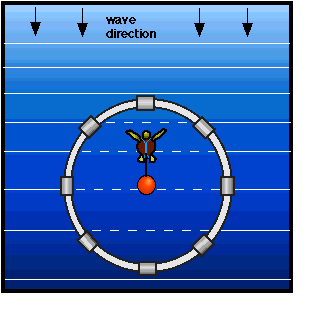
WAVE ORIENTATION - FIELD EXPERIMENTS
Immediately after entering the sea, hatchlings establish a course toward the open ocean and maintain it as they swim away from shore. To determine if turtles rely on the direction of ocean waves to guide themselves seaward, hatchlings were tethered inside a floating orientation arena placed at various distances offshore along the Florida coast .

Results:
In a second series of experiments, green turtle hatchlings were released at sea under typical conditions when waves moved shoreward and during unusual weather conditions when waves moved in atypical directions.
Results:
Interpretation:
Hatchling sea turtles maintain seaward orientation early in the offshore migration by using wave propagation direction as an orientation cue. Because waves and swells entering shallow, coastal areas are refracted until they approach a beach directly, swimming into waves reliably guides turtles away from land and toward the open sea.
Next Question:
These results raise a new question. To use waves as an orientation cue, hatchlings entering the ocean at night must be able to determine wave direction while swimming under water in almost total darkness. How can they do this?
Reference: (Lohmann & Lohmann 1992)